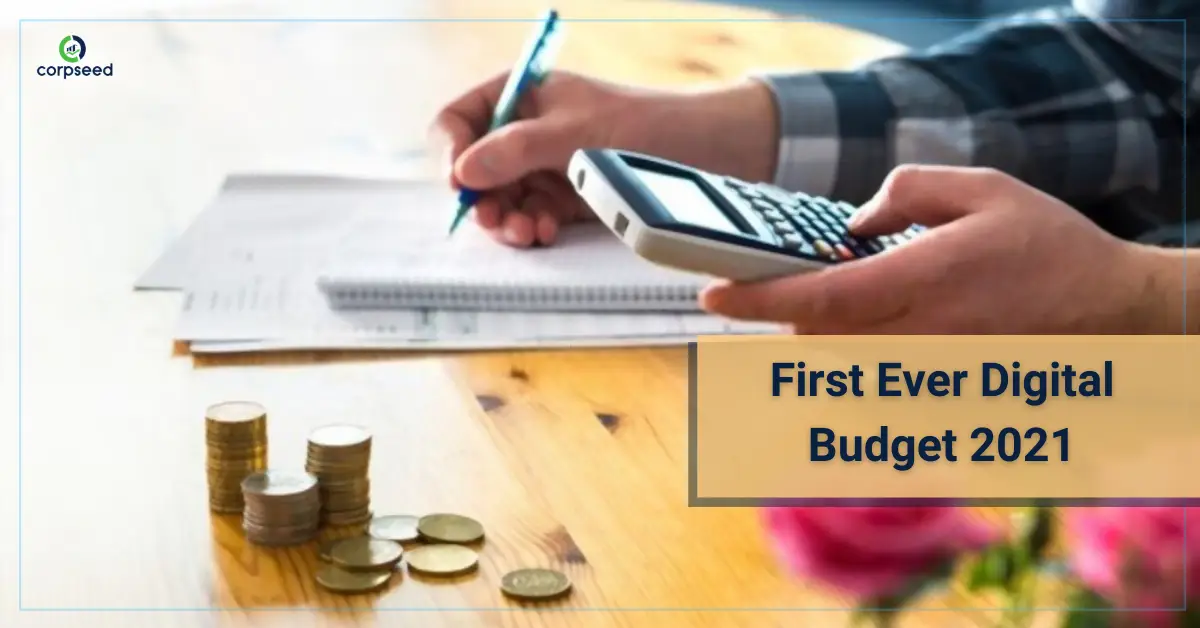Introduction
Recent times has been really tough for the whole world. Same time previous year problems for everyone in the world were very different. Countries were tackling problems like terrorism, war and whatnot. But everything changed in the blink of an eye. Nightmares turned into reality when a germ rattled the whole world. People lost their job, revenues plummeted, most businesses were shut, and people were forced into shelters not knowing how to compete with skyrocketing expenses. Roads were empty for God’s sake. To conclude, the year 2020 brought problems that is massacre for any country. Countries were wishing for a booming economy but had to face severe problems instead.
Table of Contents
This year’s budget was the most special one in the past century. People were glued to televisions waiting for the finance minister to show the light from the darkness that the year 2020 has drained on people. People were eagerly waiting to listen to the schemes the finance minister has figured to boom the drowning economy of the country.
When the finance minister, Nirmala Sitharaman presented the budget this year, experts observed intently, people were waiting eagerly to hear the innovative ideas that would boom the economy. To cope the damage the lockdown brought, the Indian government had to borrow from the market. Therefore, shooting India’s debt to GDP. It is an important number. The debt to GDP ratio determines the government’s ability to spend and if it stays at sky-high for a long time, it would result in an economic slowdown. It will be scary for lenders, high ratio and less possibility of spending.
The booming economy is a situation when citizens earn more meaning they pay more taxes which would create revenue for the Government. Then such revenue would be utilized in the building of Infrastructure, jobs and service debt. Growth in GDP means growth in the government’s ability to raise and service debt.
Higher debt as a proportion to the GDP means slow growth and a shrinking in revenue of the government resulting in debt servicing becoming a huge expenditure. That means very less in being spent on infrastructure and jobs. According to a report of the World Bank, when public debt is 64%, any point increase in that goes on to cost 0.02 % points in annual growth.
India is at the most risk than any other country as harvesting of the demographic dividend in a 10-year window of opportunity is coming to an end. The reason is that India is growing older. India youth, i.e. aged under 29 is estimated to drop by about 9 million in the next decade and the number will increase by about 140 million of people above the age of 30.
But nothing is impossible where there is hope and faith. India can still rise up, all is needed, are ambitious ideas. To think of something, India can start by building new centres of economic development in the states of Madhya Pradesh and Uttar Pradesh. Apart from Delhi and its extensions, there is not one city in northern India that can be considered as accounting for the country’s GDP. Major growth centres are south and west.
That is why all eyes were on Sitharaman today, whether she will guide India to a better tomorrow, everyone was glued to the television to hear the strategies of the government for the web of problems India is in right now.
This was the first digital budget in the history of India. It was in furtherance of the Prime Minister's digital India mission. Key points of this year’s budget is as follows.
Kick for Start-ups
- One Person Companies (OPC) are permitted for start-ups with the benefits of
- No restriction on turnover and paid-up capital
- Any type of company is allowed to convert
- Reduction in residency limit to 120 days from 182 days.
- Extension of tax holidays for start-ups by 1 year till 31st March of 2022.
Announcements related to Tax
- Rs. 1.5 lakh deduction for affordable housing loans till 31st March 2022.
- Senior citizens are exempted from ITR returns. Citizens above 75 of age and having pension and interest income only.
- Capital gains from listed securities and dividend income to be included in pre-filing.
- Reopening of income tax assessment reduced to 3 years from 6 years.
- Faceless Income Tax Appellate Tribunal
- Dispute Resolution Committee to be constituted for small taxpayers.
- Relaxation on dividend payment from REIT/Invlt.
- Tax audit from 5 crore to 10 crore (having 95% digital transactions) to be undertaken by an increase in entities.
Corporate Sector
- Permanent institutional framework to be created in order to purchase investment-grade debt securities, irrespective of whether the times are stressed or normal.
- Raising funds through notified infrastructure debt funds by issuance of zero coupon bonds.
Financial Sector
- Allocation of Rs.20,000 crores for DFI (Development financial institution) for long-term infrastructure financing.
- Setting up of Asset Management Company and Asset Reconstruction Company (ARC) for the purpose of taking over existing NPAs in PSBs.
- Rationalization of a single Securities Market Code by year 2022.
- Insurance companies to enjoy an increase in FDI limit from 49% to 74%.
Fiscal Scenario
- Deviation in fiscal deficit according to the estimate revised at 9.5% in comparison to the budget estimate of 3.5%.
- Total gross borrowing from the market will be Rs. 12.8 lakh crores for the year 2021 as Rs. 80,000 crores will be raised in February and March of 2021.
- Finance Minister visions the reduction of fiscal deficit by 2026 by 4.5% and a steady decline over this period.
- NSSF and market borrowing will be the source of funding for the fiscal deficit for the year 2026.
- Market budget provisions will replace the NSSF loan to FCI for food subsidy.
- Rs. 135 lakh crore is the estimated outstanding debt, i.e. 61% of GDP.
- State governments are permitted a fiscal deficit at 4% of GSDP for the year 2022 along with a relaxation of 0.5%. States are estimated to achieve 3% target of fiscal deficit by 2024.
Infrastructure Sector
- NIP (National Infrastructure Pipeline): Projects increased to 7,400 and completion of projects worth of Rs.1.1 lakh crores.
- Launching of Mega Investment Textile Parks along with 7 textile parks aimed to be established within 3 years.
- Rail in freight to be increased to 45% from 27% by 2030: National Railway Plan for 2030.
- Brownfield infrastructure assets to experience national monetization pipelines.
- Introduction of Development Financial Institution set-up bill.
- Power: Power distribution companies to enjoy a total outlay of Rs. 3.1 lakh crore. Moreover, the government plans to launch a Hydrogen energy mission.
- Urban Development: Announcement of Voluntary Vehicle Scrapping policy.
- Rs. 18,000 crore for augmentation of public bus transport by introducing innovative PPP models.
- Technologies are prepared to be deployed in Tier-II cities and peripherals of Tier-I cities, namely, MetroNeo and MetroLite.
General
- Allocation of 64,180 crores for New Health Schemes.
PM Atmanirbhar Swasth Bharat Yojana is announced to be launched at this outlay over the period of the next 6 years.
- Allocated of 35,000 crores for Covid Vaccine.
Finance Minister considered health and well-being as one of the six pillars of the union budget.
- 5.54 lakh crore provided for Capital Expenditure.
Finance Minister considers capital expenditure as one of the pillars of the union budget and is really keen to promote it by way of this budget.
- 1.18 lakh crore for the Ministry of Roads.
Concern for roads has been an issue and this budget aims for the development of roads.
- 1.10 lakh crore allocated to Railways.
- Deposit Insurance cover (DICGC Act 1961 to be amended). Helping depositors of stress banks by easy and time-bound access of deposits.
- Proposal to revive the definition of ‘Small Companies’ under the Companies Act 2013. Capital less than 2 Cr. and Turnover Less than 20 Cr.
- Disinvestment: IPO of LIC, Announced Disinvestment of Companies will be completed in FY 2021-22
Direct and Indirect tax
- Relaxations to NRI: Propose to notify rules for removing hardship for double taxation.
- Propose to include tax holidays for Aircraft leasing companies.
- Prefilling of returns (Salary, Tax payments, TDS etc.) Details of Capital gains from listed Securities, dividend income, etc. will be prefilled.
- Small Charitable Trusts. Increased from 1 crore to 5 crore (Compliance limit).
- Late deposit of an employee’s contribution by the employer will not be allowed as a deduction.
- Duties reduced on various textiles, chemicals and other products
- Gold and Silver (BCD reduced)
- Agriculture Products: Custom duty increased on cotton, silks, alcohol etc.
Quoting Rabindranath Tagore, “Faith is the bird that feels the light when the dawn is still dark” finance minister presented first paperless budget which has been touted to be the most important budget in the century that aims to bring back the drowning GDP and bring about development in the country. India is in need of that. This budget can be considered as the last straw Indian GDP is holding to. The financial sector, infrastructure sector, and health sector has been focused on the budget. Sitharaman also mentioned the pillars of this year’s budget. That is, health and well-being, physical, financial capital and infrastructure, inclusive development for aspirational India, reinvigorating human capital, innovation and R&D and minimum government and maximum governance.
Analysis the Revenue Receipts
- In FY21 (RE), revenue receipts are expected to contract by 8 per cent following the effects of the pandemic, economic activity lockdowns and limitations. Receipts are forecast to rise in FY222 by 15 per cent (BE).
- Gross tax revenues are expected to increase in FY22 (BE) by 16.7 per cent after recording a 5.5 per cent contraction in FY211 (RE).
- Budgetary gross tax revenue growth of 16.7% is marginally higher than nominal GDP growth of 14.4% in FY222.
- In both FY21 (RE) and FY22, the tax (net) to GDP ratio was held at 6.9. (BE). The buoyancy of taxes is budgeted at 1.2 if compared to 1.3 in FY211.
- Corporate tax (Rs 2.4 lakh crores), corporate income tax (Rs.1.8 lakh crores), and personal income tax (Rs.1.8 lakh crores) is deficient in FY21 (RE) revenue receipts. GST, other non-tax income (1.8 lakh crores) (1.2 lakh crores) respectively.
- In almost all tax revenues for FY22(BE), double-digit growth is estimated: personal income tax (22%), corporate tax (23%), GST (22%), and Customs(21%).
Subsidies: Expenditure and Major Schemes
- Decentralized procurement of food grains and high expenditure under the NFS act resulted in food subsidies have almost tripled in FY21 (RE) compared to FY20.
- The fertilizer subsidy is also estimated to grow by 65% following the high demand for urea and nutrients. The government announced an additional fertilizer subsidy of Rs. 65,000 crores in November 2020.
- Fertilizer subsidy, 40% contract allocated to FY22 (BE).
- Petroleum subsidy is estimated to be about 65% in FY22 (BE) due to the removal of the paraffin subsidy and stable crude oil prices. Key schemes set aside for FY22 (BE) shortfall include: MGNREGA: Rs.0.38 lakh crores and PMAY: Rs.0.13 lakh crores.
- Metro projects, highway and road works have seen a significant increase in their FY22 (BE) budget allocation.
Capital Receipts: Disinvestments and Borrowings
- The investment policy of Rs.1.8 lakh crore of FY22 can be a challenged if given the receipts in this account are very efficient past budget targets.
- The Central Fund's incentive package may be created to encourage the State to invest less.
- Financial management in the system will be pressured by high borrowing from state and national markets and high demand in private sector finance through economic growth
- The government's budget deficit has increased from 3% to 4%, resulting in higher market borrowing.
- Interest rates may face higher pressures as financial conditions tighten.
- To obtain a yield from the RBI it will be necessary to proceed with measures to supply the liquid with OMO, TLTRO and LTROs.
- The additional Rs.80,000 required to finance the FY21 financial expenditure can be met through a market loan mid-February-March.
Analyzing the Revenue Expenditure
- Revenue is projected to grow by 28.1% in FY21 (RE) and is projected to decrease by 2.7% in FY22 (BE).
- Expenditure to address 84% of the total budget size of less than 87% in FY21 (RE).
- Key heads that have led to significant increases in FY21 (RE) revenue include:
- food allowance (Rs.3.1 lakh crores)
- interest payments (Rs.0.8 lakh crores)
- fertilizer subsidy (Rs.0.5 lakh crores)
- Family health and welfare schemes (Rs.0.12 lakh crs)
- The slight decrease in FY22 (BE) expenditure is mainly due to the decline in intermediate sector plans of approximately Rs2.7 lakh crores (including fertilizer subsidy, food subsidy).
- At the same time, interest costs are set to increase by Rs.1.2 lakhs while the financial commission transfers by Rs.0.4 lakh crores.
Capital Expenditure: Main Areas
- The basis for spending is on security, roads and railways.
- 3 components account for 63% of the budget expenditure spent on FY22.
- Reimbursements have increased (from the revised FY21 rating)
- 18% Roads
- Increased expansion of urban housing, telecommunications, medium and large sector expenditure strategies
- Reduced cash withdrawals are reduced/retained in the event of security and railways.
Did it comply with expectations? Oh sure yes, as the Finance Minister took a brave move not to procrastinate main spending at a time when the fiscal deficit is now running very high and there appear to be very few new sources of revenue. The FM, instead, has the achievement of the fiscal consolidation goal was rightly moved by a few years to make room to continue borrowing more. It will be lower compared to last year, however, targeting a 6.8 percent fiscal deficit and maintaining an extended timetable until we move. It makes a lot of sense as the government's first goal unambiguously had to be "growth" in order to get it back on the rails of the post-pandemic economy.
This portion of the site is for informational purposes only. The content is not legal advice. The statements and opinions are the expression of author, not corpseed, and have not been evaluated by corpseed for accuracy, completeness, or changes in the law.
BOOK A FREE CONSULTATION
Get help from an experienced legal adviser. Schedule your consultation at a time that works for you and it's absolutely FREE.








